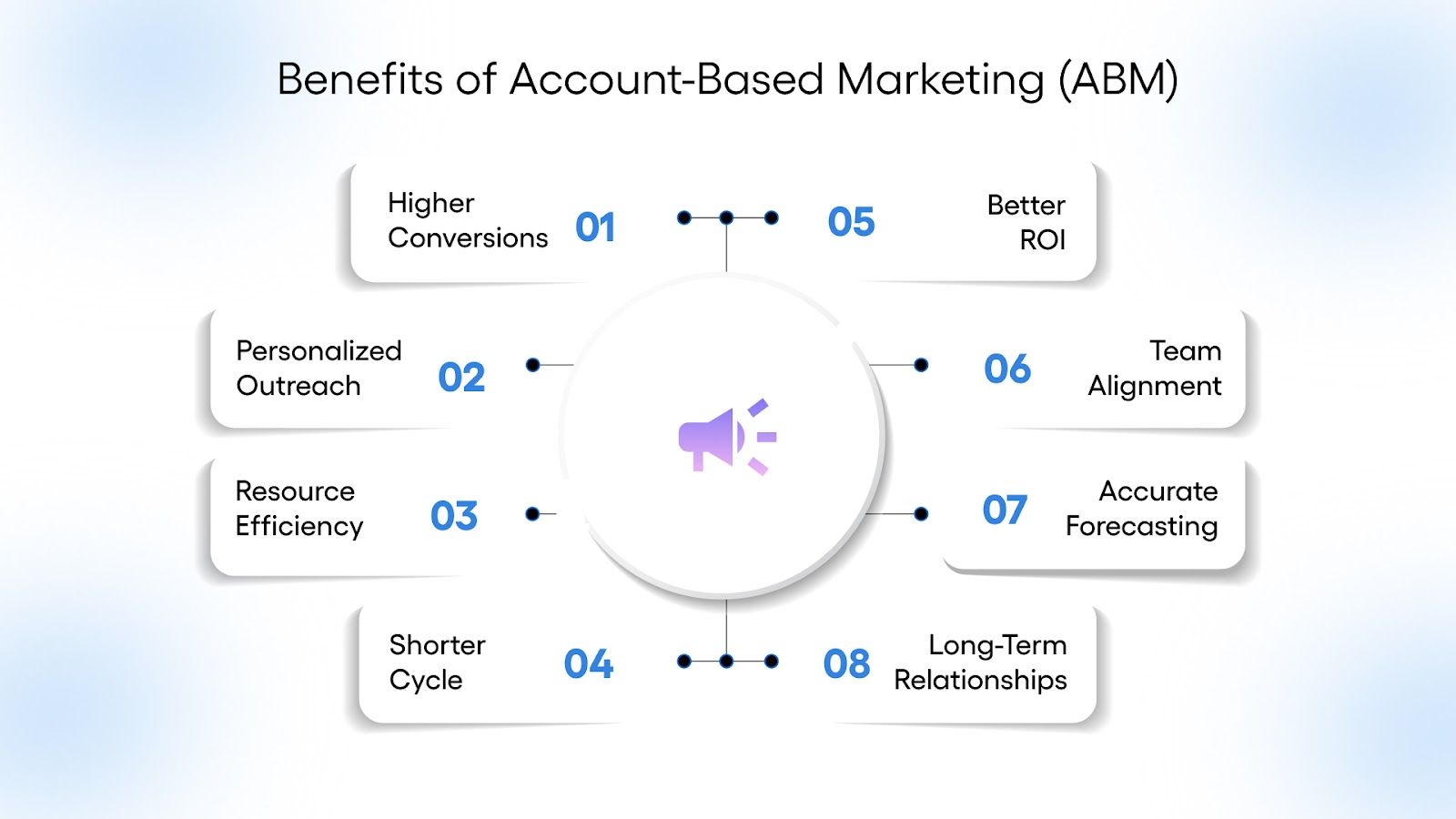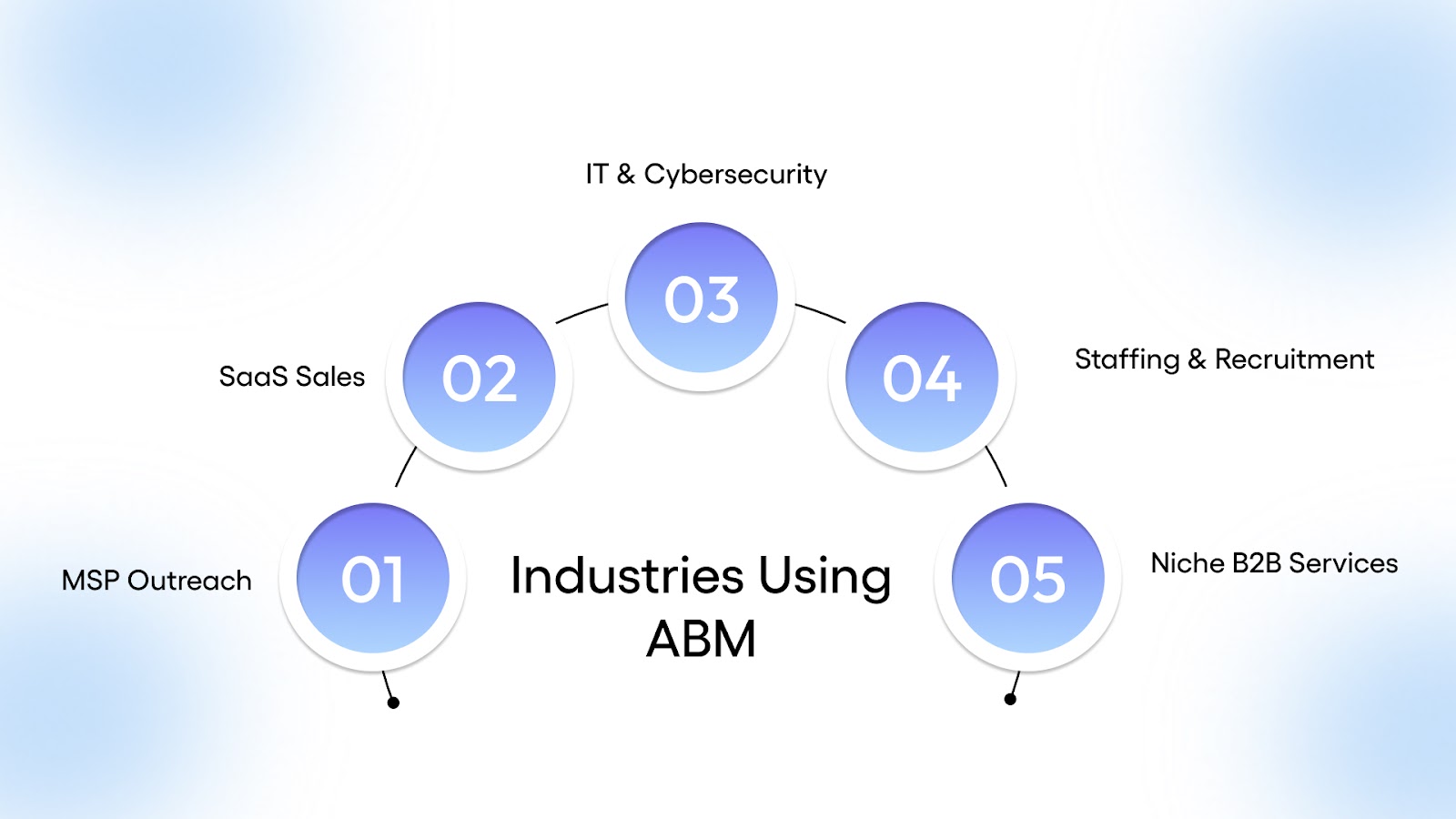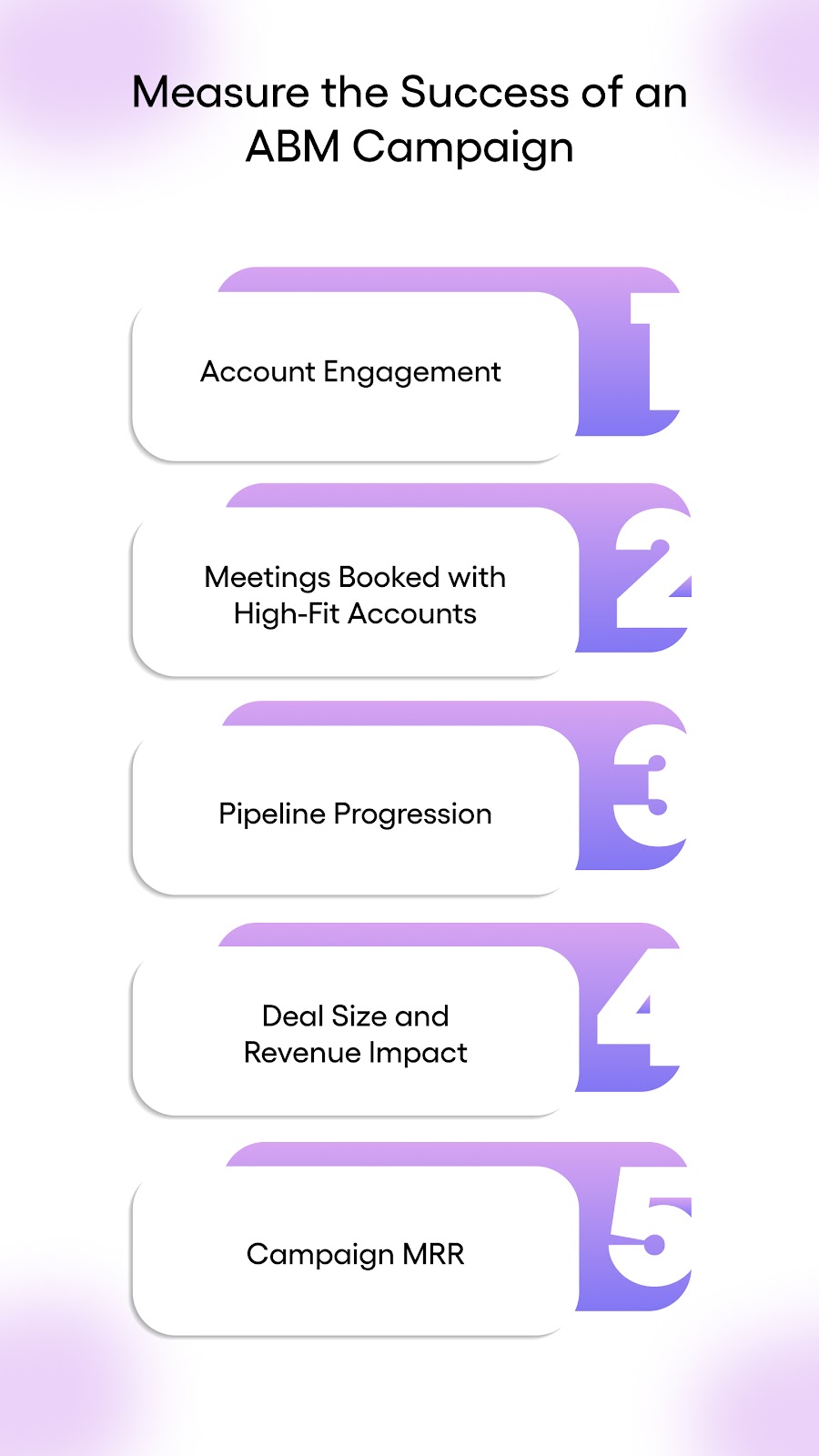
Creative Strategies for Effective ABM Outreach

Are you struggling to connect with the right decision-makers and get your outreach efforts to pay off truly?
In 2025, 30% of marketing efforts will be dedicated to Account-Based Marketing (ABM), with ABM adoption growing at a rate of 15% annually in the U.S. B2B sector. The problem is clear: traditional broad-based marketing simply isn’t enough anymore. Companies are shifting focus to high-value accounts that are more likely to convert and become long-term partners. The challenge lies in executing ABM outreach that cuts through the noise and delivers the right message at the right time. This blog dives into how creative strategies can transform your ABM outreach, turning qualified accounts into engaged opportunities that close faster and more effectively.
From aligning teams to mastering personalized engagement, we'll break down practical, results-driven approaches to ABM that lead to tangible business growth. Let’s explore how you can make your ABM efforts count.
TL;DR
- ABM is a focused strategy that targets high-value accounts, leading to higher conversion rates and faster sales cycles.
- Personalized engagement is key, using tailored content and multi-channel outreach to connect with the right decision-makers.
- Sales and marketing alignment is crucial for ABM success, ensuring consistent messaging and efficient follow-ups.
- Measure success by engagement, meetings, pipeline progress, and revenue impact to track the real outcomes of your ABM efforts.
What is Account-Based Marketing (ABM)?
For businesses that want to cut through the noise and avoid wasting precious resources on leads that never convert, Account-Based Marketing (ABM) is the solution. It’s a strategy that allows you to focus on the accounts that matter most, those that align with your Ideal Customer Profile (ICP), instead of spreading your efforts across a broad, unqualified audience. In industries like MSPs, staffing, technology, and manufacturing, ABM transforms the way companies approach lead generation, shifting from generic outreach to personalized, high-impact campaigns.
By zeroing in on key decision-makers and tailoring messaging to their specific challenges and needs, ABM fosters meaningful connections, improves conversion rates, and maximizes the sales pipeline’s potential. It’s about working smarter, not harder, and delivering measurable results that drive growth and revenue. With ABM, you can finally stop wasting time on prospects who won’t engage and start focusing on those who will.
Now, let's see why ABM can change the game for your sales and marketing efforts.
Benefits of Account-Based Marketing (ABM)

Account-Based Marketing (ABM) offers a wealth of benefits that can transform your sales and marketing efforts. Here’s how it can help businesses like yours thrive:
- Higher Conversion Rates: ABM targets high-value accounts, ensuring that marketing and sales teams focus on prospects who are most likely to convert, resulting in higher conversion rates.
- Personalized Engagement: With ABM, outreach is tailored to each target account’s needs, pain points, and decision-makers. This level of personalization leads to more meaningful interactions and builds stronger relationships.
- Efficient Use of Resources: By focusing on fewer, but more qualified, accounts, ABM helps you use your resources more effectively. Instead of spreading your efforts thin, you concentrate on what really drives results.
- Shorter Sales Cycle: ABM allows you to align your sales and marketing teams, streamlining the sales process and accelerating the time it takes to close deals.
- Improved ROI: By focusing on high-value accounts, ABM drives better outcomes, leading to higher returns on your marketing investments and ultimately boosting Monthly Recurring Revenue (MRR).
- Enhanced Alignment Between Sales and Marketing: ABM ensures that both your sales and marketing teams are on the same page, working toward shared goals and improving communication and collaboration.
- Better Forecasting and Reporting: ABM allows for more accurate tracking of progress with specific accounts, making it easier to measure performance and adjust strategies to achieve better results.
- Stronger Long-Term Relationships: ABM fosters deep, ongoing relationships with target accounts, leading to more opportunities for repeat business, referrals, and long-term success.
This is exactly how TLM helps growth-focused businesses turn high-intent accounts into long-term clients through focused, personalized ABM strategies that drive faster closes, stronger relationships, and higher returns.
With those benefits in mind, let’s talk about how to put ABM into action.
Smart Strategies to Reach the Right Accounts with ABM
Account-based outreach works best when it’s focused, personal, and based on real business needs, not just volume. If you want to reach high-value companies, your approach needs to go beyond standard marketing tactics. These strategies are built to help your team connect with the right people, have better conversations, and turn interest into real opportunities.
1. Create Personalized Content
Skip the generic sales pitch. Make your message feel like it was written just for them. When reaching out to a company, use details that show you’ve done your homework, like a recent product launch, hiring activity, or market trend. You can also create short videos, one-pagers, or case studies that speak directly to their industry or role. Personal touches make a big difference in getting a reply.
2. Target Your Ads and Outreach
Don’t try to reach everyone, but focus only on the companies that actually matter. ABM works best when you spend your time and budget on accounts that fit your ideal customer profile. This means running ads or sending emails only to the businesses that are more likely to buy. It saves time, keeps your team focused, and improves your chances of success.
A Managed Service Provider in Rhode Island partnered with TLM to focus outreach on companies with 11–50 employees. With clean list-building, tailored email messaging, and a consistent four-touchpoint sequence each month, the MSP closed 18 new clients, including two generating $13.5K and $17K in monthly recurring revenue. Their pipeline is now stable, and their business is positioned for acquisition, all from targeted, high-relevance outreach.
3. Align Sales and Marketing
Sales and marketing should work together like one team, not two separate ones. Everyone needs to agree on which companies to go after, what messages to use, and when to follow up. This avoids confusion and makes your outreach feel more consistent. It also helps move leads through the pipeline faster, since everyone’s on the same page.
4. Engage Across Multiple Channels
Use more than one way to reach people. It increases your chances of getting noticed. Start with an email, follow up on LinkedIn, then maybe call or run a targeted ad. The goal is to show up where your prospect already is, without overwhelming them. A mix of channels keeps your brand visible and your message fresh.
5. Try Creative, Unconventional Tactics
Sometimes, doing something a little different is what gets a response. This could mean sending a short video instead of a regular email. Even sending a coffee voucher before a meeting can leave a good impression. Small, thoughtful gestures show that you’re serious about working with them, not just pushing a sale.
6. Communicate Real Value
Tell them clearly how you can help, not just what you do. Most decision-makers are busy. They need to know what result they can expect from working with you. Can you save them time? Help them get more clients? Make their processes easier? Be specific and show how your solution can solve a real problem.
7. Personalize with Data
Use what you know about a company to shape your message. If you know they’re growing fast, talk about how your service supports scaling. If they just switched tech platforms, mention how you can make the transition smoother. The more your email reflects what’s happening in their business, the more likely they are to respond.
Knowing what to do is one thing, but where does ABM work best? Let’s check out the industries that see real results.
Industries Succeeding with ABM for Business Growth

Account-Based Marketing works best in industries where the sales cycle is longer, the deal size is larger, and decisions involve multiple people. In these sectors, it’s not about reaching more leads, it’s about reaching the right companies with a message that speaks directly to them. ABM helps teams stay focused on high-value opportunities and close deals faster.
Here are a few industries seeing strong results from ABM outreach:
- Managed Service Providers (MSPs): With long-term contracts and highly specific services, MSPs benefit from targeted outreach to decision-makers like CTOs or operations heads. ABM helps MSPs cut through the noise and book meetings with companies that are ready to switch or scale.
- SaaS and Software Companies: ABM supports long sales cycles by keeping the conversation going across channels. It’s especially effective when selling platforms that involve cross-functional buying teams (IT, finance, operations).
- IT and Cybersecurity Firms: These solutions are complex and high-stakes. ABM helps teams tailor their messaging based on a company’s security posture or tech stack, making outreach more relevant and urgent.
- Staffing and Recruitment Agencies: In a competitive hiring market, ABM allows staffing firms to focus on companies actively growing or hiring, offering targeted value and better timing.
- B2B Services with Niche Clients: ABM is ideal for businesses targeting a specific type of company, by size, location, or industry. It reduces wasted effort and helps secure long-term contracts by speaking directly to known needs.
If you're in a high-touch industry and want to reach companies that convert, TLM’s account-based marketing services are built to help you focus, connect, and close with the accounts that matter most.
Understanding the industry helps, but it’s the sales team that keeps things moving, and we can now check on that.
How Does Sales Contribute to ABM?
ABM is a marketing approach that requires full collaboration between sales and marketing teams. Its success depends on their close cooperation.
Here’s how the sales team plays a key role in ABM:
- Choosing the Right Accounts: Sales teams help identify which companies are the best fit to target, based on past wins, deal size, or signals of readiness. These insights make sure marketing isn’t guessing.
- Shaping the Messaging: Sales knows what questions prospects ask and what objections come up. That knowledge helps marketing create emails, ads, and content that actually connect.
- Timely Follow-Up: Once a lead engages with ABM content, sales steps in quickly. A fast, relevant follow-up turns interest into real conversations.
- Providing Feedback: Sales can see which messages work and which fall flat. Sharing this feedback helps improve future campaigns and keep outreach aligned with real buyer needs.
TLM supports this alignment by building custom outreach campaigns that keep sales teams looped in from day one, so your ABM efforts aren't just well-targeted, but ready to convert.
Sales and marketing need to work together, but how do you know if it’s paying off? Let’s look at the numbers that matter.
How Do You Measure the Success of an ABM Campaign?

Unlike traditional lead generation, ABM outreach focuses on quality over volume. You’re not just measuring how many leads came in; you’re evaluating how well you engaged with the right companies, progressed deals, and contributed to revenue.
Here are five key ways to measure success:
1. Account Engagement
ABM is about engaging a specific list of high-value companies. Metrics like opens and clicks matter less than how the entire account is interacting with your outreach.
What to track:
- Replies from key stakeholders
- Website visits from target domains
- LinkedIn profile views and connection acceptances
- Repeat interactions across multiple team members
With real-time campaign dashboards and industry-specific targeting, TLM shows you exactly which accounts are active and who’s engaging within them.
2. Meetings Booked with High-Fit Accounts
Conversations are the real goal. If your ABM campaign doesn’t result in booked meetings, something’s off with targeting or messaging.
What to track:
- Number of appointments booked with target accounts
- Meeting-to-proposal conversion rates
- Time from first touch to scheduled call
How TLM helps: Our appointment scheduling services ensure your sales team only speaks to qualified, ready-to-convert leads, saving time and driving momentum.
3. Pipeline Progression
ABM doesn’t stop at booking a meeting. Success is also measured by how fast and how far leads move through your pipeline.
What to track:
- Stage-to-stage movement
- Proposal rates and deal acceleration
- Number of stakeholders involved from the account
TLM builds multi-step, personalized outreach campaigns that keep leads engaged throughout the sales cycle, not just at the top of the funnel.
4. Deal Size and Revenue Impact
High-value accounts should lead to high-value deals. Your ABM success should be tied to what closes, not just who replies.
What to track:
- Average deal value from ABM-targeted accounts
- Closed-won revenue contribution from ABM leads
- Win rate vs. non-targeted leads
By focusing on accounts that match your Ideal Customer Profile (ICP), we help our clients secure larger, longer-term contracts, often leading to a threefold increase in revenue within a year.
5. Campaign MRR
At the end of the day, your ABM strategy should translate into measurable revenue, not just activity.
Key metrics to watch:
- Cost per Sales Qualified Lead (SQL)
- Outreach spend vs. qualified pipeline created
- Revenue generated per campaign cycle
TLM structures every campaign around performance metrics that tie directly to recurring revenue goals, helping you track impact, reduce waste, and focus on what actually drives growth.
Tracking progress is important, but turning that data into action takes the right support. hence TLM offers several set of services and now lets see that in detail.
Make Every ABM Metric Count, With TLM
Your ABM campaign should drive more than engagement; it should create measurable sales outcomes. Whether you're looking to improve visibility across the funnel or convert interest into revenue, TLM helps you close that loop.
With deep experience in account-level targeting and performance-driven outreach, we support sales teams with the tools and services needed to track and influence ABM success from first touch to closed deal.
Here’s how TLM supports measurable ABM performance:
- Appointment Setting: Book qualified meetings with decision-makers from your target accounts, not random leads.
- Account-Based Campaigns: Multi-touch outreach strategies built around your ICP, tailored by industry, size, and buying intent.
- Real-Time Dashboards: Monitor engagement and pipeline progression by account, in one place.
- Lead Qualification Support: Ensure that every prospect passed to your team meets the agreed-upon sales-readiness criteria.
Want to build an ABM system that delivers real meetings, revenue, and reporting clarity? Schedule a Meeting with the team about structuring your ABM strategy for full-funnel visibility and sales outcomes!
FAQs
1. What is Account-Based Marketing (ABM)?
ABM is a strategy where businesses focus their marketing efforts on high-value, targeted accounts rather than casting a wide net. It’s about engaging decision-makers at key companies with tailored content and messaging.
2. How does ABM improve conversion rates?
By focusing on high-value accounts and delivering personalized outreach, ABM ensures that marketing and sales efforts are concentrated on the most promising prospects, leading to higher conversion rates.
3. What are the benefits of aligning sales and marketing in ABM?
When sales and marketing teams work together, they ensure a consistent message,faster follow-up, and a smoother transition from lead generation to closing deals, ultimately accelerating the sales cycle.
4. How do I measure the success of an ABM campaign?
Key metrics for ABM include account engagement, meetings booked, pipeline progression, deal size, and revenue impact, ensuring that the strategy leads to real, measurable outcomes.
5. What is the best way to engage accounts with ABM?
Engage high-value accounts by creating personalized content, using multiple outreach channels (email, LinkedIn, ads), and providing real value to address the specific needs and challenges of each account.






